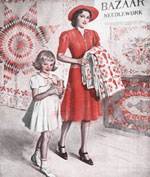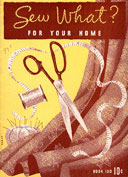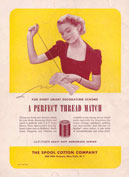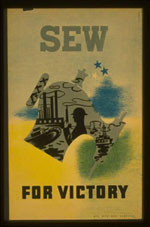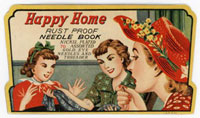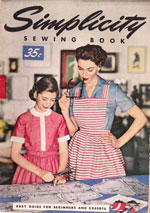Sewing History
Sew Retro takes readers through the history of sewing, from the 19th century, right up to today. Here is an abbreviated version, hitting some of the highlights from the last few hundred years.
1850s: Singer sewing machines hit the market in 1853, after inventor Isaac Singer improves upon existing sewing machine designs and comes up with the first marketable one. Dressmaker Ellen Curtis Demorest makes the first commercial patterns in the U.S. (There’s a bit of disagreement about the actual date they became available, but 1854 is the most reliable year I could find.)
1850s: Singer sewing machines hit the market in 1853, after inventor Isaac Singer improves upon existing sewing machine designs and comes up with the first marketable one. Dressmaker Ellen Curtis Demorest makes the first commercial patterns in the U.S. (There’s a bit of disagreement about the actual date they became available, but 1854 is the most reliable year I could find.)
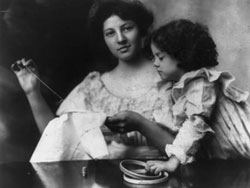
Library of Congress.
1860s: Women (from both the North and the South) form sewing societies. They get together and make quilts to sell at church bazaars (to raise money for their causes), and to make warm clothes and quilts for their soldiers. Many women in the North are active in anti-slavery societies and produce quilts with anti-slavery messages. In 1863, Ebenezer Butterick makes the first graded, or sized, patterns, and Butterick patterns are born. (The first patterns were just for men, but patterns for women and kids came along a few years later.)
1890s: Pattern companies (there were a bunch of them by now—many of the ones we recognize, like McCalls and Vogue) started selling patterns in envelopes with directions, resembling something like the modern pattern we know today.
1890s: Pattern companies (there were a bunch of them by now—many of the ones we recognize, like McCalls and Vogue) started selling patterns in envelopes with directions, resembling something like the modern pattern we know today.
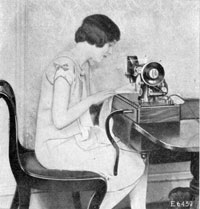
A 1920s illustration of a woman and her
sewing machine, courtesy Singer
Sewing Company.
sewing machine, courtesy Singer
Sewing Company.
1910s and 1920s: More clothing is sold ready-made, which means that women don’t have to sew as much. Sewing begins to wane a little bit by the mid-1920s. The Women’s Domestic Institute, a correspondence school that teaches women how to sew and set up seamstress businesses, is started and soon led by Mary Brooks Picken, author of more than 90 sewing books.
1930s: The Depression hits. Surprisingly, sewing doesn’t make the resurgence you’d expect (though New Deal programs set up sewing rooms around the country to employ out-of-work seamstresses). People mend clothes more and make do with less. Women begin sewing more with feedsacks (the colorful cloth sacks that held staples like sugar, grain, and flour). In 1939, the National Cotton Council is formed and starts promoting feedsack sewing.
1930s: The Depression hits. Surprisingly, sewing doesn’t make the resurgence you’d expect (though New Deal programs set up sewing rooms around the country to employ out-of-work seamstresses). People mend clothes more and make do with less. Women begin sewing more with feedsacks (the colorful cloth sacks that held staples like sugar, grain, and flour). In 1939, the National Cotton Council is formed and starts promoting feedsack sewing.
1940s: World War II brings about a huge revitalization in sewing. Women sew for the war effort, and there’s a heavy focus on repurposing old clothes. Classes at sewing centers and colleges teach women how to do what we now call “upcycling.” Stores hold promotions (like “Sew and Save Week”) to encourage women to reconstruct and update old dresses or slipcovers. By 1942, fabric sales were up 50 percent over the previous year, and in 1943, there were 70 million patterns sold over the counter (25 million more than in 1939).
1950s: We regard the 1950s as sewing’s golden age (and this decade is a huge inspiration for today’s retro sewing), but truthfully, the numbers waned a bit (because the economy was booming and women could afford ready-mades again). But there was a strong focus on fashion sewing, designer patterns, and copying Hollywood looks. In some ways, sewing became more chic. In 1955, 52 million women and girls in the U.S. were sewing.
1950s: We regard the 1950s as sewing’s golden age (and this decade is a huge inspiration for today’s retro sewing), but truthfully, the numbers waned a bit (because the economy was booming and women could afford ready-mades again). But there was a strong focus on fashion sewing, designer patterns, and copying Hollywood looks. In some ways, sewing became more chic. In 1955, 52 million women and girls in the U.S. were sewing.
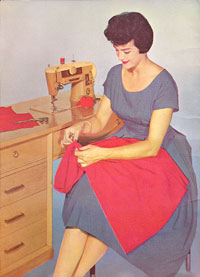
From the Singer booklet, How to Measure, Alter,
and Fit (1960), courtesy of Singer Sewing Company.
and Fit (1960), courtesy of Singer Sewing Company.
1960s: The youth movement sweeps sewing, and it booms again. In 1963, American women spent a record $1 billion on sewing—including patterns, fabric, notions, and sewing machines. By 1964, the average age of the home sewer was 25 years younger than in 1940. Between 1960 and 1968, the amount of clothes sewn at home increased by 50 percent.
1970s: Hippy handcrafts take the market by storm! The overall sewing numbers are down (44 million women and girls sew in 1974—8 million less than in the 1950s), but the back-to-basics idea of making something with your own hands appeals to a generation of young women fed up with mass consumerism (sound familiar?)
1980s: The “me” decade doesn’t do much to promote sewing. Fiber arts become an area of interest, however, and the art world begins to look at quilting as a relevant form of artistic expression.
1990s through today: A 1997 Home Sewing Association survey put the number of American women sewing at about 30 million. By 2006, that number was 35 million. (It’s hard to get numbers for today because no one seems to be tracking it anymore since the HSA disbanded a few years ago.) But we know that sewing is booming again, thanks in large part to the Web (especially sites like Etsy) and the DIY/eco-chic movement.
Images are protected by individual copyright and are reproduced here with permission. They may not be reproduced without written permission from the individual companies.
1970s: Hippy handcrafts take the market by storm! The overall sewing numbers are down (44 million women and girls sew in 1974—8 million less than in the 1950s), but the back-to-basics idea of making something with your own hands appeals to a generation of young women fed up with mass consumerism (sound familiar?)
1980s: The “me” decade doesn’t do much to promote sewing. Fiber arts become an area of interest, however, and the art world begins to look at quilting as a relevant form of artistic expression.
1990s through today: A 1997 Home Sewing Association survey put the number of American women sewing at about 30 million. By 2006, that number was 35 million. (It’s hard to get numbers for today because no one seems to be tracking it anymore since the HSA disbanded a few years ago.) But we know that sewing is booming again, thanks in large part to the Web (especially sites like Etsy) and the DIY/eco-chic movement.
Images are protected by individual copyright and are reproduced here with permission. They may not be reproduced without written permission from the individual companies.
